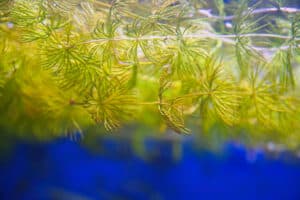Though a lot of people would try to get rid of duckweed in their tanks, some aquarium hobbyists really do like these floating plants for both aesthetic value and practical reasons.
And though duckweed is typically quite aggressive and might end up taking over the whole surface of the water, there are certain cases when it won’t be able to thrive.
Duckweed might die if there is too much current in the aquarium. Not enough nutrients and/or light and drastic shifts in the pH level are the factors that might also kill the plant.
Below you will discover a few other reasons why your duckweed might be dying and helpful tips on how to solve the problem.
6 Reasons Why Your Duckweed Is Dying and Ways to Fix That
1. There Is Too Much Surface Movement
CAUSE:
If you want your duckweed to thrive, you should use the least amount of current. The plant likes almost stagnant water, so it doesn’t go well with powerheads.
FIX:
If you have to have surface movement, get a 90-degree elbow, so that the bubbles get pushed at the water surface.
Otherwise, a filter will ‘throw’ water all over the place and make the duckweed sink (this plant hates getting water on top of its leaves).
You can also create a floating ring or section off a part of the aquarium so that the duckweed has a safe space to grow. You can use silicone tubing for that, like this one:
By the way, such a solution would allow you to control the growth rate of the plant a bit better.
2. There Is Not Enough Nutrients in the Aquarium
CAUSE:
In order to grow, the plant needs plenty of nitrates and phosphates.
Basically, if you have enough fish and just the right number of duckweed, they will create a very stable system as the plant is going to consume the nitrates produced by fish wastes, decomposing plant matter, and leftover food.
If there is too much duckweed, it will eventually run out of nutrients and will start to die.
FIX:
To make sure that the plant does not take up the entire surface of the aquarium, manually remove a portion of duckweed every week.
You can also choose to add natural predators that feed on duckweed (like grass carp, koi, or goldfish). These fish would be happy to snack on the plant. To encourage the little guys to eat more duckweed, you can try to give them just a tiny bit less fish food.
It is also a great idea to have a freshwater plant fertilizer at hand, like this one:
3. There Is Not Enough Light
CAUSE:
If the leaves of your plant have become white or almost translucent, then the chances are high that it is not getting enough light to ensure that photosynthesis is taking place.
FIX:
Duckweed is used to growing in brightly lit ponds, so it does best in direct sunlight. Though it can tolerate poor light conditions, you won’t get the growth that you might be expecting. So, try to provide the plant with at least 6 hours of light every day.
If you’re looking for the best lighting setup for your duckweed planted aquarium, I would highly recommend checking this Fluval LED light. It is a high-quality and feature-rich aquarium light, perfect for planted tanks.
4. There Has Recently Been a pH Shift
CAUSE:
Duckweed can survive in a relatively wide pH range (5.0-9.0), but it grows best at a range of 6.5-7.5.
The plant might start to die if the pH is not right, or if there has been a rapid pH shift in the aquarium. If the latter is the root cause of the problem, then you will most likely notice other issues with the aquarium as well.
Dead plants and fish are the most common reasons for a higher-than-usual pH level, but even the less obvious things such as filter media, aquarium substrates, and even decorations might affect the overall pH.
Also, remember that anything that you’re adding to the tank might change the water parameters. Furthermore, two or more additives can react with each other or the aquarium’s water and cause a pH change.
FIX:
To avoid such problems, you should:
- Keep the number of chemicals that you’re adding to the tank to a minimum and always read the labels to find out how the additive will affect the pH level
- Ensure that the decorations and other add-ons that you’re placing in the tank are suitable for use in the type of aquarium that you’re keeping
- Check your filter and make sure that it’s still effective
- Do routine maintenance of your tank each week and constantly monitor the pH inside the aquarium
5. You Haven’t Moved the Duckweed to the Aquarium Correctly
CAUSE:
There is a proper way of putting duckweed in your aquarium. And if you fail to do that, the plant will fail to establish itself in the tank.
FIX:
Here’s exactly what you would have to do:
- Get duckweed from a pet store or collect it from a pond. Around 50-100 pods should be enough. Make sure to put the duckweed directly in a container with water.
- Now, you would have to disinfect the plant to remove any bugs or bacteria. Dilute 12 gallons of water with a teaspoon of potassium permanganate. Soak your duckweed in the solution for only about 30 seconds.
- Fill in a plastic tray that is 12-14 inches deep with freshwater or some water from your tank. You might not want to use tap water as, in a lot of cases, it has way too many elements in it.
- Place the tray right next to a window, so that your duckweed can get over 10 hours of sunlight every day.
- Check the plant 2 times per day and remove any duckweed that did not survive. Change the water in the tray in a week.
- You should be able to see rapid growth in 10 days or so. Once you have enough duckweed, use a net to carefully move the plant to your aquarium.
6. Your Aquarium Is Not Freshwater
CAUSE:
In nature, duckweed can be found in freshwater bodies, like ponds, lakes, rivers, and streams.
Though the plant is extremely adaptable and well-suited to a wide range of growing conditions, it will not survive in saltwater.
FIX:
It might thrive in mildly brackish tanks, but freshwater aquariums are typically recommended.
Read Next: How Long Will A Aquarium Plant Take To Root?
Hi! I’m Praveen Ghoshal, the founder of eFishkeeping.com. Inspired by my Dad, I got interested in fishkeeping when I was a kid. Since then, I have been involved with this hobby. Currently, I have 3 fish tanks at our home, and I enjoy this hobby with my full family. Read more about me here.





![Why Are Anubias So Expensive? [Reasons + Cheap Alternatives] why-are-anubias-so-expensive](https://efishkeeping.com/wp-content/uploads/2022/12/anubias-in-a-planted-aquarium-300x200.jpg)




